The Intel Haswell Refresh Review: Core i7-4790, i5-4690 and i3-4360 Tested
by Ian Cutress on May 11, 2014 3:01 AM ESTCPU Synthetic Benchmarks
Content Creation - Cinebench
Based on MAXON’s CINEMA 4D animation software, Cinebench is used to determine the CPU and graphics performance via OpenGL. The software has gone through many iterations over the years, and here we use versions 10, 11.5 and 15 to compare single-threaded and multi-threaded CPU performance. As the generations increase, the software becomes more multithread aware and scales better, however for consistency with older results we keep the version 10 results in our database.
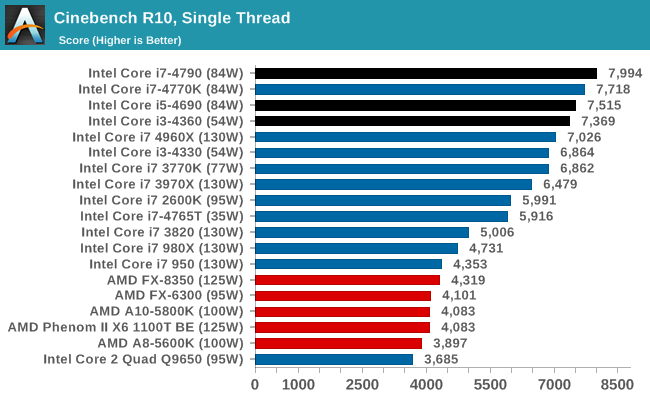

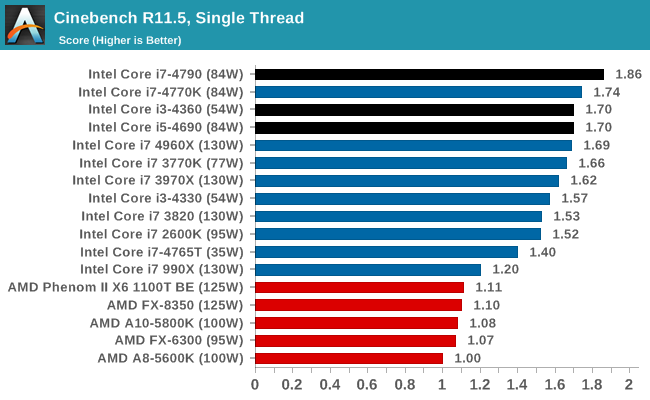
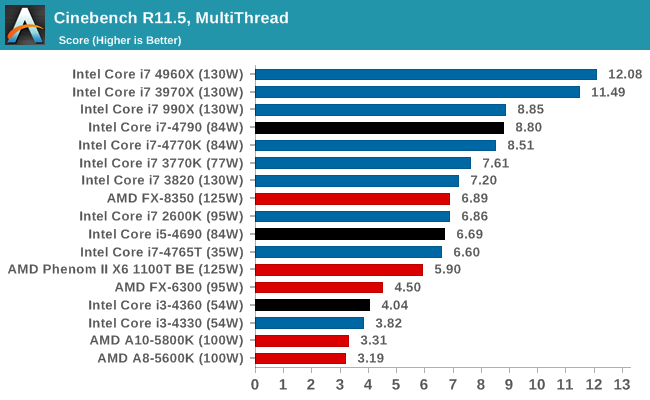

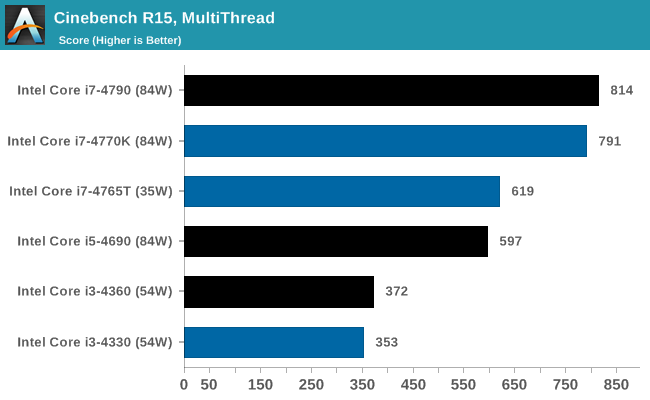
Video Conversion - x264 HD 3.03 Benchmark
Graysky's x264 HD test uses x264 to encode a 4Mbps 720p MPEG-2 source. The focus here is on quality rather than speed, thus the benchmark uses a 2-pass encode and reports the average frame rate in each pass.
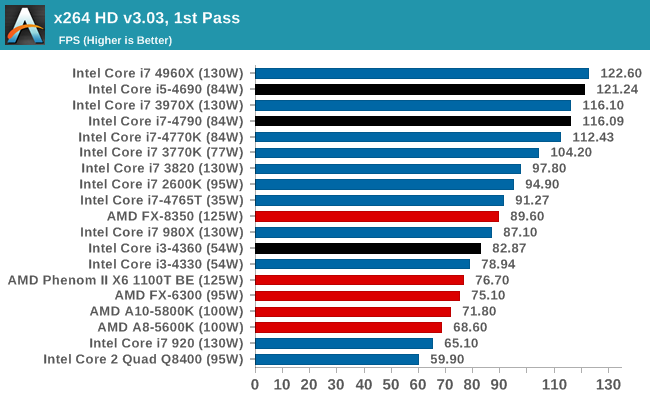

Encryption –TrueCrypt v0.7.1a: link
TrueCrypt is an off the shelf open source encryption tool for files and folders. For our test we run the benchmark mode using a 1GB buffer and take the mean result from AES encryption.
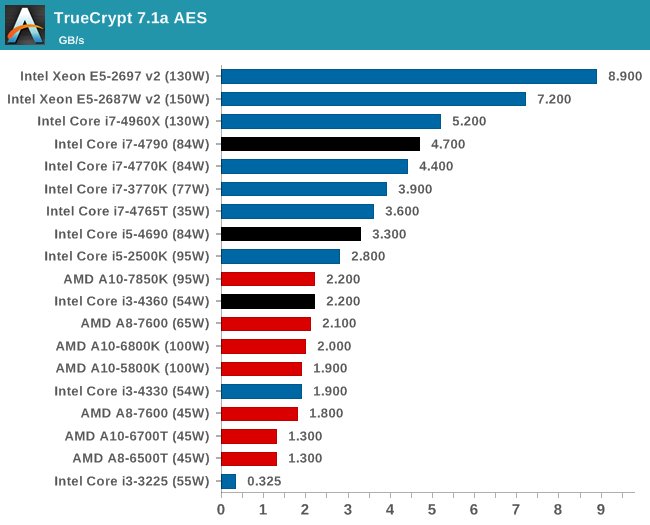
Synthetic – 7-Zip 9.2: link
As an open source compression tool, 7-Zip is a popular tool for making sets of files easier to handle and transfer. The software offers up its own benchmark, to which we report the result.
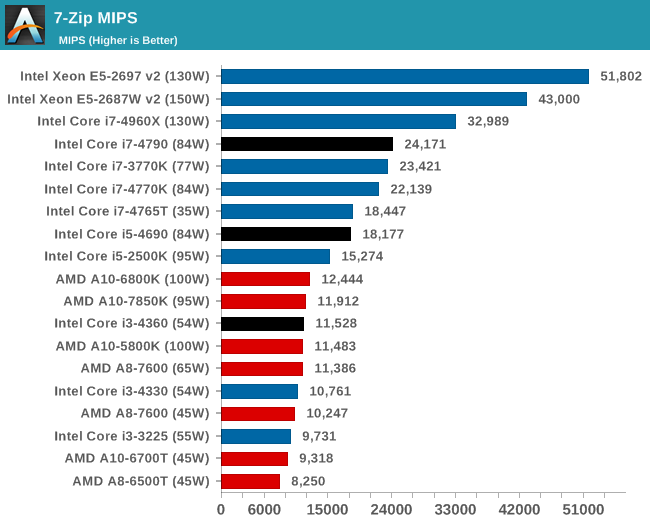
Rendering – PovRay 3.7: link
The Persistence of Vision RayTracer, or PovRay, is a freeware package for as the name suggests, ray tracing. It is a pure renderer, rather than modeling software, but the latest beta version contains a handy benchmark for stressing all processing threads on a platform. We have been using this test in motherboard reviews to test memory stability at various CPU speeds to good effect – if it passes the test, the IMC in the CPU is stable for a given CPU speed. As a CPU test, it runs for approximately 2-3 minutes on high end platforms.
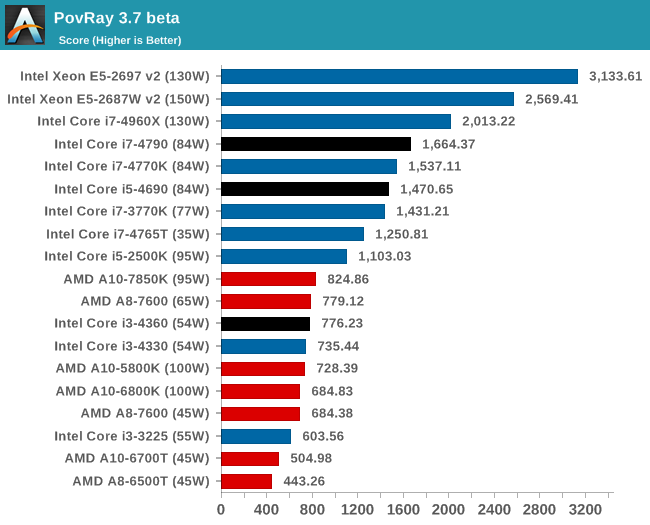
Console Emulation –Dolphin Benchmark: link
At the start of 2014 I was emailed with a link to a new emulation benchmark based on the Dolphin Emulator. The issue with emulators tends to be two-fold: game licensing and raw CPU power required for the emulation. As a result, many emulators are often bound by single thread CPU performance, and general reports tended to suggest that Haswell provided a significant post to emulator performance. This benchmark runs a Wii program that raytraces a complex 3D scene inside the Dolphin Wii emulator. Performance on this benchmark is a good proxy of the speed of Dolphin CPU emulation, which is an intensive single core task using most aspects of a CPU. Results are given in minutes, where the Wii itself scores 17.53; meaning that anything above this is faster than an actual Wii for processing Wii code, albeit emulated.
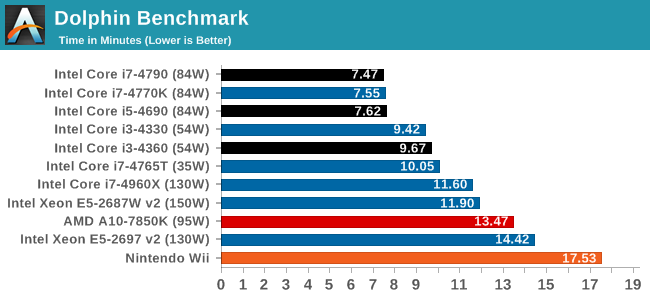
Dolphin relies very much on architecture as well as CPU single thread speed. It would also stand to reason that there is a small about of thread switching going on, given how far off the i3 and i7-4765T CPUs are.










130 Comments
View All Comments
MrSpadge - Monday, May 12, 2014 - link
Am I the only one to notice that especially in the first benchmarks the 4790 often outperforms the 4770K by ~6%, sometimes even by 11% (e.g. the very first benchmark)? Veryfiying an expected lack of improvement is nice, but not even commenting on such discrepancies seems.. not like usual Anandtech quality. If I were you I'd repeat those benchmarks and - if verified - would try to find the reason for the 4790 (sometimes) performing significantly better than expected.stephenbrooks - Saturday, May 24, 2014 - link
Yes, that's weird: the improvement is greater than the clock bump.RickyBaby - Monday, May 12, 2014 - link
So, would like to thank Ian on another job well done. A thankless job no doubt, as per the discussions this was a purely marketing driven release and offered essentially nothing of value. I did have one question though. And as background, I, like it appears most here are running and older, home built rigs like I am. Rigs built several generations ago which compete very well with today's rigs.I am an over-clocker from way back and like to squeeze out a little extra performance ... just to know that I haven't been cheated, lol. JK. Anyway, I'm thinking of buying a i3 and overclocking it what little I can or even go for an i5 - K chip. So, what overclocking options are available any more. ANY ???
The multi-core enhancement question for K processors was not answered in this article. Does it work on the 97 chipset with the new haswell's or not ??? And the does the limited bclk overclocking work ? Again, i3 (locked) and 97 chipset, does it work or not ? I'm sure that I'm not the only to realize that a 3.7 i3 with a bclk of 108 would be a cool 4.0 ghz. And that my friends is locked at 4.0. 1 cpu, 2 cpus, and even 3 and 4 via ht and all at 4.0 ghz. Since i5s and i7s throttle down depending on # CPUs being utilized ... up until more than 4, it seems that an i3 would kick ass. And here is where most could agree. Do I do ANYTHING that requires more than 4 cpus, 100% clocked at 4 ghz for large stretches of time ? NO. I. DO. NOT. And the difference in cache between an i3 (4mb) and an i7 (6mb) is again pretty much meaningless. Anyone know the diff in hit rates? 96% vs 97% ? So and even slightly overclocked i3 would make for an enticing $ proposition.
But this all gets ignored. Ian, care to address the overclocking situation in a follow up article ? And no, I'm not referring to Devils Canyon or the unlocked Pent; which is core limited (2, no HT) and cache limited. But for people who buy an non-K haswell. What options do they have and does it make a real difference ? I do wonder what intel would think if an i3 overclocked just a little bit would out perform every stock i5 and i7 though. Probably not a happy camper.
Antronman - Tuesday, May 13, 2014 - link
K series is core unlocked. Overclock it or underclock it to any clock rate you want.Non-K is core locked, you can only use turbo boost which is a very small increase in clock.
RickyBaby - Tuesday, May 13, 2014 - link
Sorry but you didn't answer the question. Can anyone ? Or is this some sort of no-no answer that everyone is supposed to give to satisfy the GIANT in the room. That GIANT of course being Intel.So why the confusion? Here is why, Toms just did a roundup of some of the new mobos and addresses overclocking. On that section (page 23 I believe) there are 3 charts. The middle chart gives the maximum base clocks for each of the motherboards on each of the 3 strap settings. The Gigabyte mobo reached a bclock of 114 with the strap set to 100. Which is the default and is unchangeable on non-k chips. You cannot change the strap but I do believe that you can change the clock. Would that not be a 14% overclock. If not, why not. The comment on the the Tom's page again seems to imply but not out and out claim you could overclock ANY locked CPU by 14% using that board. Here is exactly what he said:
"the Z79X Gaming 5 reached the highest base clock frequency when using the 100 MHz strap. That’s the only ratio available on multiplier-locked processors, so this might be important to anyone running the new Core i7-4790"
Why would that be important ? Because the 4790 is not a K and is therefore locked. But you could still overclock it by 14% .. which is how I read that.
And Tom's again muddies the waters. In that same article in review of the ASUS board on the 3rd page it talks about bios settings for overclocking and the use of the XMP setting. Again a quote:
"Unless you're using a K-series CPU, overclocking is limited to a handful of 100 MHz speed bins over stock. So, we reverted to our Core i7-4770K to test it."
So does XMP, multi-core enhancement still exist and still work for NON-K cpus ? Apparently it does. With the latest chipset (97) and latest chips (4th gen) too.
Sorry but I wish someone would just come out and say it. If your board supports BCLK increases then you can overclock to that amount. Not that is not a lot; most boards i've seen are 5%-7%. And if your chips supports Turbo then XMP/Mult Core Ehancement is alive and well too. So take an i5, increase bck by 10% and lock your Max Turbo using XMP and you'd have a decent overclock of 15%-20% under a heavy load.
I'm just waiting for someone (like Ian) to confirm/deny that the above is true.
MrSpadge - Tuesday, May 13, 2014 - link
Ricky, your concern is very valid! When Haswell launched I had hoped to get i7 4770R with Crystalwell L4 cache and to be able to set all cores to 3.9 GHz (max single core turbo), unlimited power consumption and a BCLK of 102.5 - 107.5 MHz for 4.0 - 4.2 GHz. This could run at very energy efficient ~1.00 V and would outperform pretty much every other quad core if the L4 works well (>10% performance per clock) and otherwise still be decent. Without any heat problems (power consumption would probably be below a stock 4770).BUT there were reports of multi core enhancement not working for non-K models. Which renders such a plan useless, before I even get to the point that you can not buy 4770R soldered onto a regular mainboard (just those notebook-expensive mini boxes).
JokerProductions - Tuesday, May 13, 2014 - link
Still the same horrible 1150 socket, but now with a 2% performance gain. Yay! Still waiting on X99 and my 8 core.eanazag - Tuesday, May 13, 2014 - link
Finally some bench love. I see the scores are in the bench. I'd like to see some updates to what AMD is still selling as far as the bench apps tested. Like comparing the FX 8350 with the new Haswells gets rough with limited apps that line up.The|Hunter - Tuesday, May 13, 2014 - link
btw Intel confirmed Broadwell and Z87 compatibility back in September 2013;One intel ceo/rep said: "Broadwell is going to enable 2 types of devices, One you can plug the chips directly into existing systems (z87) and Second we will have brand new systems with broad new range of fanless designs.."
https://www.youtube.com/watch?feature=player_detai...
*z87 and devil canyon needed IMEI uefi firmware update..
jjjag - Wednesday, May 14, 2014 - link
Desktops ARE dying. Stop saying they are not. Desktop silicon is exactly the same as mobile silicon, and has been for several generations. The number of SKUs that are sold into desktop has been rapidly declining, driven by the declining number of desktop computers that are offered by people like Dell and HP, which of course is driven by demand.HEDT, a.k.a. "Extreme", is different silicon than mobil/desktop since the 2nd gen. Core parts. These are server parts that are de-featured and re-badged as desktop. The volumes are too small and declining to justify these for much longer.
To answer another's question: you will not see a desktop with Iris Pro until Broadwell. Unless you count that little Gigabyte box that uses the Haswell Iris Pro.
To respond to another. Intel is not sabotaging anything. To believe that is ignorant. It's all driven by demand. Once demand drops below a certain level, it does not make business sense to sell a particular part.